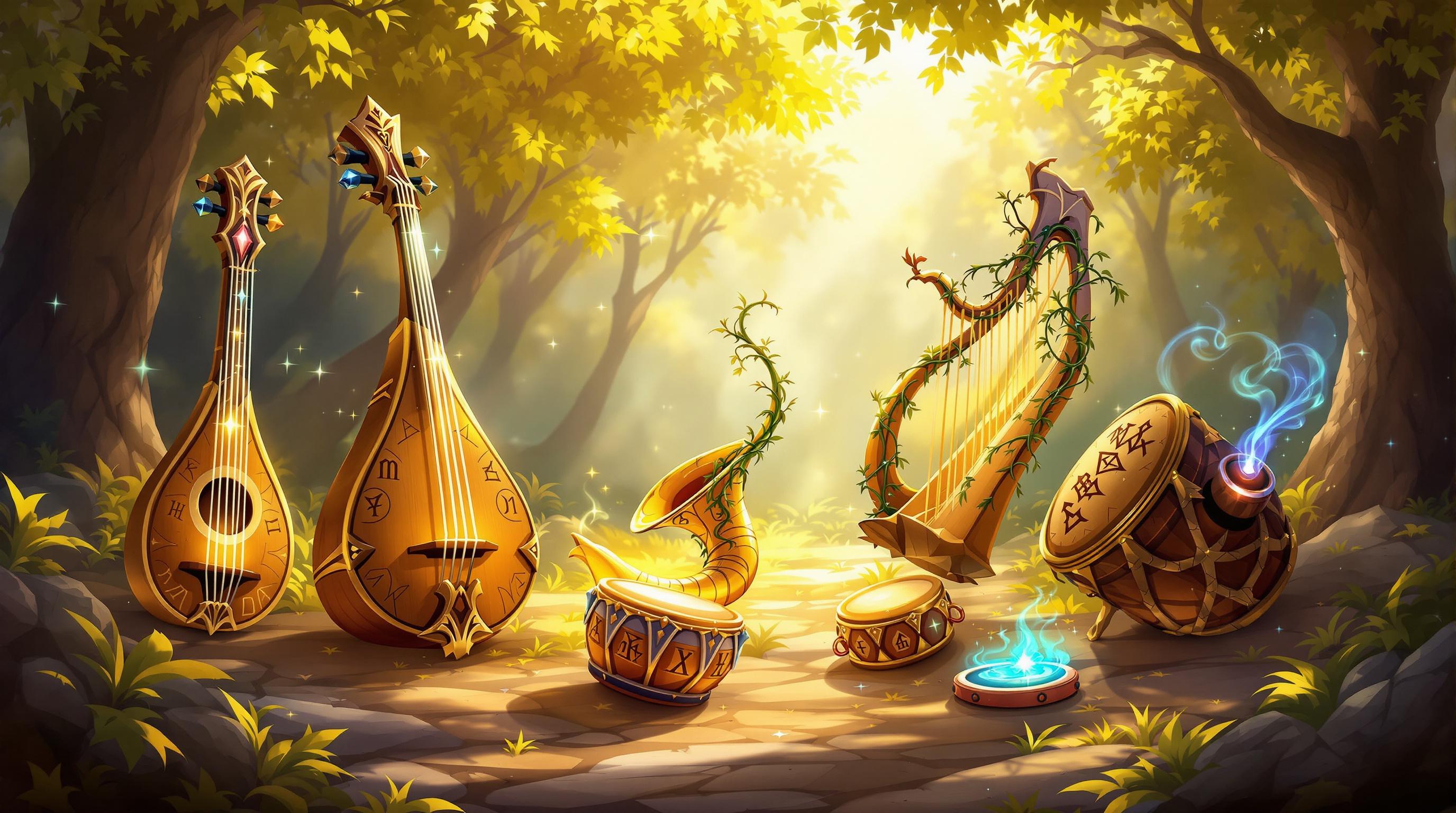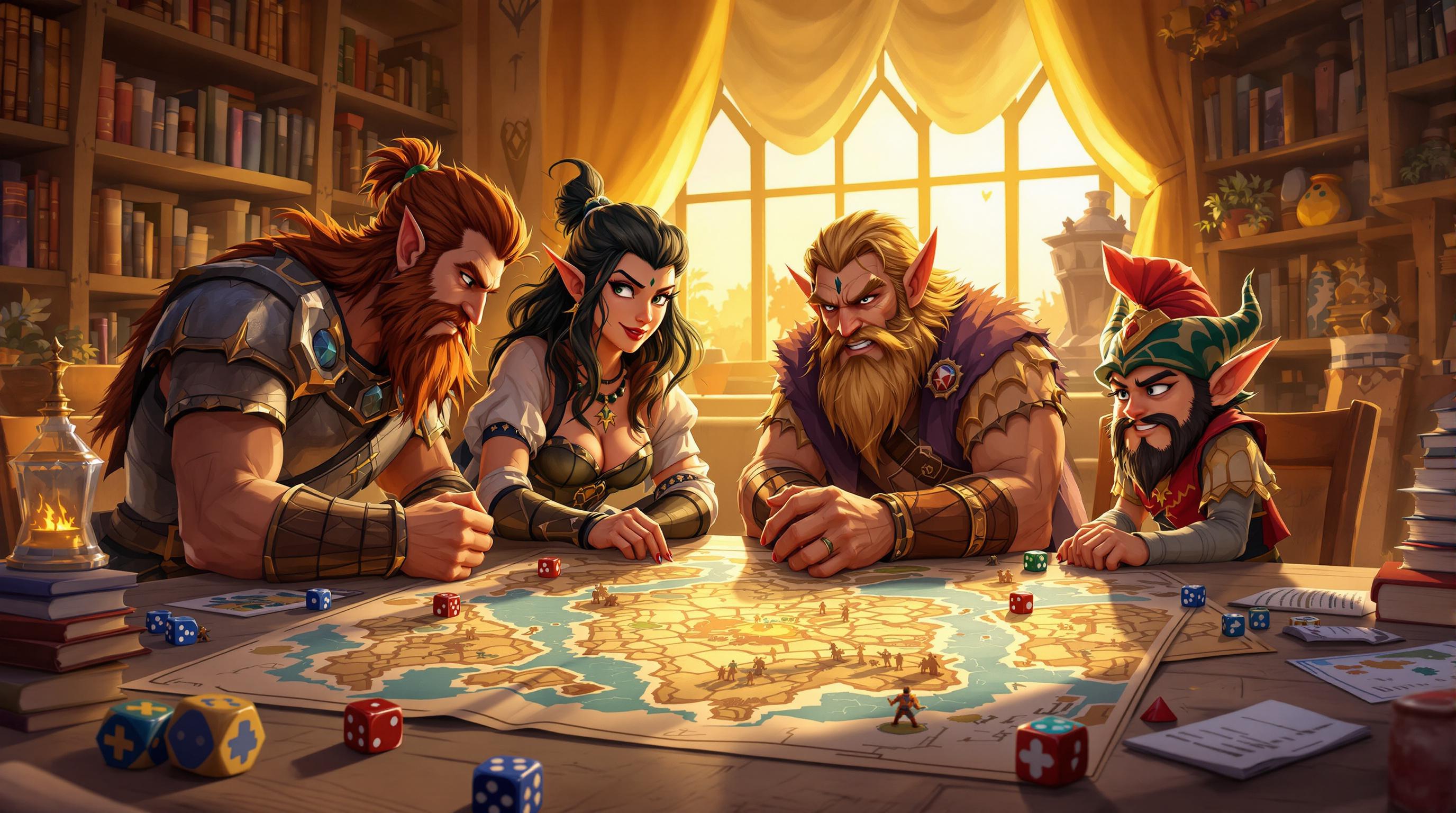Looking for simple tabletop RPGs that you can start playing in minutes? Here are 10 rules-lite TTRPGs perfect for both beginners and experienced players:
- Honey Heist - One-page game where you play as bears pulling off a honey heist
- Lasers & Feelings - Space adventure using just one rule mechanic
- Fiasco - GM-less storytelling game about plans gone wrong
- The Witch Is Dead - Play as woodland animals seeking revenge
- Roll for Shoes - Ultra-simple system where skills develop through play
- Goblin Quest - Comedy game about incompetent goblins
- Dread - Horror game using Jenga instead of dice
- The Quiet Year - Community-building through map drawing
- Crash Pandas - Street racing with raccoons
- Cthulhu Dark - Stripped-down Lovecraftian horror
| Game | Setup Time | Players | Session Length |
|---|---|---|---|
| Honey Heist | 5 min | 3-6 | 2-3 hours |
| Lasers & Feelings | 5 min | 2-6 | 1-2 hours |
| Fiasco | 15 min | 3-5 | 2-3 hours |
| The Witch Is Dead | 5 min | 2-4 | 1-2 hours |
| Roll for Shoes | 2 min | 2-6 | 1-3 hours |
These games focus on storytelling over complex rules. You can explain most of them in under 15 minutes and start playing right away. Perfect for one-shot sessions or introducing new players to TTRPGs.
Related video from YouTube
Why Choose Simple TTRPGs
Simple TTRPGs have become more popular recently, especially with the rise of the rules-lite trend, which highlights ease of entry and streamlined play. These games offer perks that make them attractive to both first-time players and long-time fans.
One big draw is their low prep time. Traditional TTRPGs often require hours of setup, but rules-lite games, such as Into the Odd, strip down character abilities and mechanics, letting players jump into the game almost immediately. And while the rules are less complex, they don’t skimp on depth. Instead, they focus on what many see as the core of role-playing: collaborative storytelling.
"The lie of the ultra-lite is that you can capture the quintessential nature of D&D despite largely removing its progression and Gygaxian building blocks." - Prince of Nothing Blogs
This quote points out an important truth: rules-lite games aren't trying to mimic more complex systems in a simpler way. They're built to deliver a different kind of experience, one that values open-ended narratives and creative problem-solving. Take Goblin Quest, for instance. Here, players control multiple goblins during a session, and the simplicity of the rules encourages crafting hilarious and memorable stories rather than getting bogged down in detailed mechanics.
Simple TTRPGs shine in certain gaming situations:
| Scenario | Why Simple TTRPGs Work Well |
|---|---|
| One-Shot Sessions | Fast setup and easy-to-learn mechanics |
| New Player Introduction | Gentle learning curve and fewer barriers |
| Impromptu Gaming | Play quickly with minimal prep |
| Story-Focused Groups | Spend more time on storytelling than rules |
Another standout feature of these games is the dynamic they create between players and Game Masters. With fewer rules to follow, the GM has more freedom to make creative decisions on the fly, leaning more on narrative judgment than rulebook pages. This creates an environment where players and GMs can collaborate more organically, often leading to unpredictable and exciting sessions.
For anyone curious about these games, know this: fewer rules don't mean less fun. Simple TTRPGs thrive on storytelling and player interaction, offering fast and engaging experiences that bring groups together for unforgettable moments. Whether you're short on time or just want a shift from complex systems, these games deliver in ways that keep the focus squarely on the fun.
1. Honey Heist
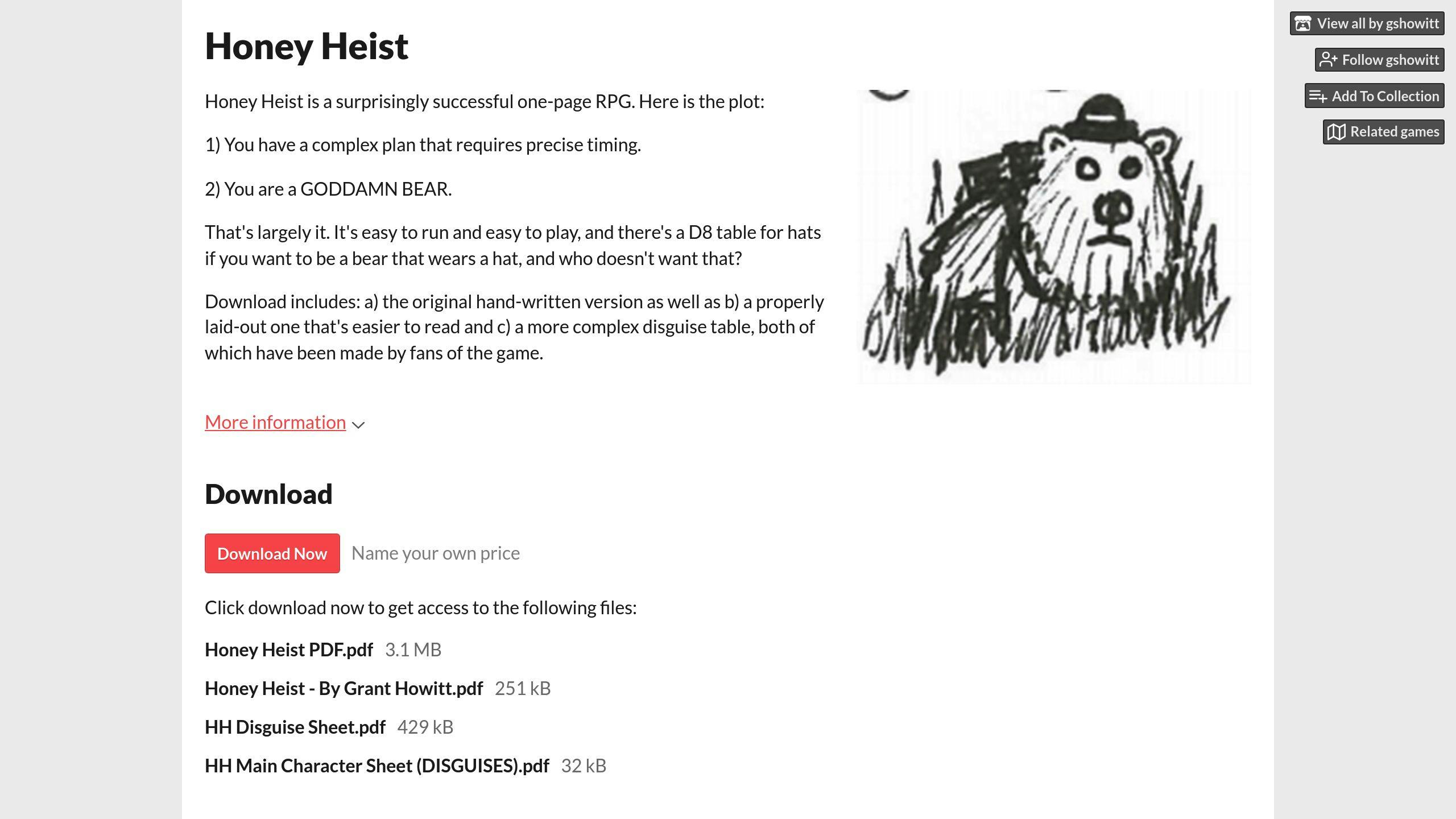
Designed by indie TTRPG creator Grant Howitt, Honey Heist is a one-page game that combines simple mechanics with a hilariously unique premise: you and your friends play as bears planning an extravagant honey heist.
"Honey Heist is a game about making a plan, and then watching as it all goes wrong." - Grant Howitt, Creator of Honey Heist
The game is incredibly easy to pick up. Using just one six-sided die (d6), players navigate their bear characters through chaotic, often outlandish situations. The rules are so streamlined that you can explain them in minutes and dive straight into the action. Despite its simplicity, the game still manages to encourage creative problem-solving and wild storytelling moments that players won't soon forget.
What makes Honey Heist such a blast is how it mixes structure with unpredictability. Players describe their bear's actions, while the Game Master (GM) resolves the outcomes based on the situation. The system is designed to spark improvisation and encourage a mix of smart strategies and comical catastrophes. Whether you're devising clever heist strategies or embracing total bear-related chaos, each session promises unpredictability and fun.
| Game Element | Description |
|---|---|
| Setup Time | Less than 5 minutes |
| Session Length | Around 2-3 hours |
| Player Count | 3-5 players |
| Core Mechanic | Single d6 dice rolls |
Available as a free or pay-what-you-want download on platforms like itch.io, Honey Heist has inspired countless spin-offs and fan-made variants. It's a great way for newbies to dip their toes into tabletop RPGs while offering seasoned players a fresh and lighthearted approach to storytelling. The game's popularity proves that even within a single page, you can craft something extraordinary.
2. Lasers & Feelings
Created by John Harper, the designer behind several indie RPG hits, Lasers & Feelings exemplifies the beauty of keeping things simple. This free-to-play space adventure RPG shows how a straightforward system can lead to engaging and memorable gameplay.
The brilliance of the game lies in its core mechanic: a single-rule system. Each player picks a number between 2 and 5, which reflects their character's balance between logical reasoning (Lasers) and emotional insight (Feelings). Every action in the game revolves around this clever concept, fostering natural character interactions while keeping play fast-paced and exciting.
"Lasers & Feelings is part of a larger movement towards rules-lite RPGs, prioritizing storytelling and player creativity over complex mechanics." - John Harper, Creator
What sets this game apart is how adaptable it is. The default setting revolves around space exploration, but its structure makes it easy to reinterpret for other genres. Over the years, fans have created countless alternate versions - or "hacks" - that take the original mechanics into new settings, from spy thrillers to cozy mysteries.
| Game Element | Description |
|---|---|
| Setup Time | Under 5 minutes |
| Core Rules | Single page |
| Player Count | 2-6 players |
| Session Length | 1-2 hours |
| Price | Free |
Because it’s so easy to learn, Lasers & Feelings is perfect for introducing newcomers to tabletop RPGs. At the same time, its emphasis on storytelling and player creativity keeps seasoned players coming back. Without the hassle of referencing thick rulebooks, this game focuses entirely on crafting stories and having fun together.
An active online community has only added to its appeal, sharing unique scenarios and clever spins on the game’s mechanics. This collaborative effort has cemented Lasers & Feelings as a staple of the rules-light RPG scene, showing how a simple idea can inspire endless possibilities in game design.
3. Fiasco
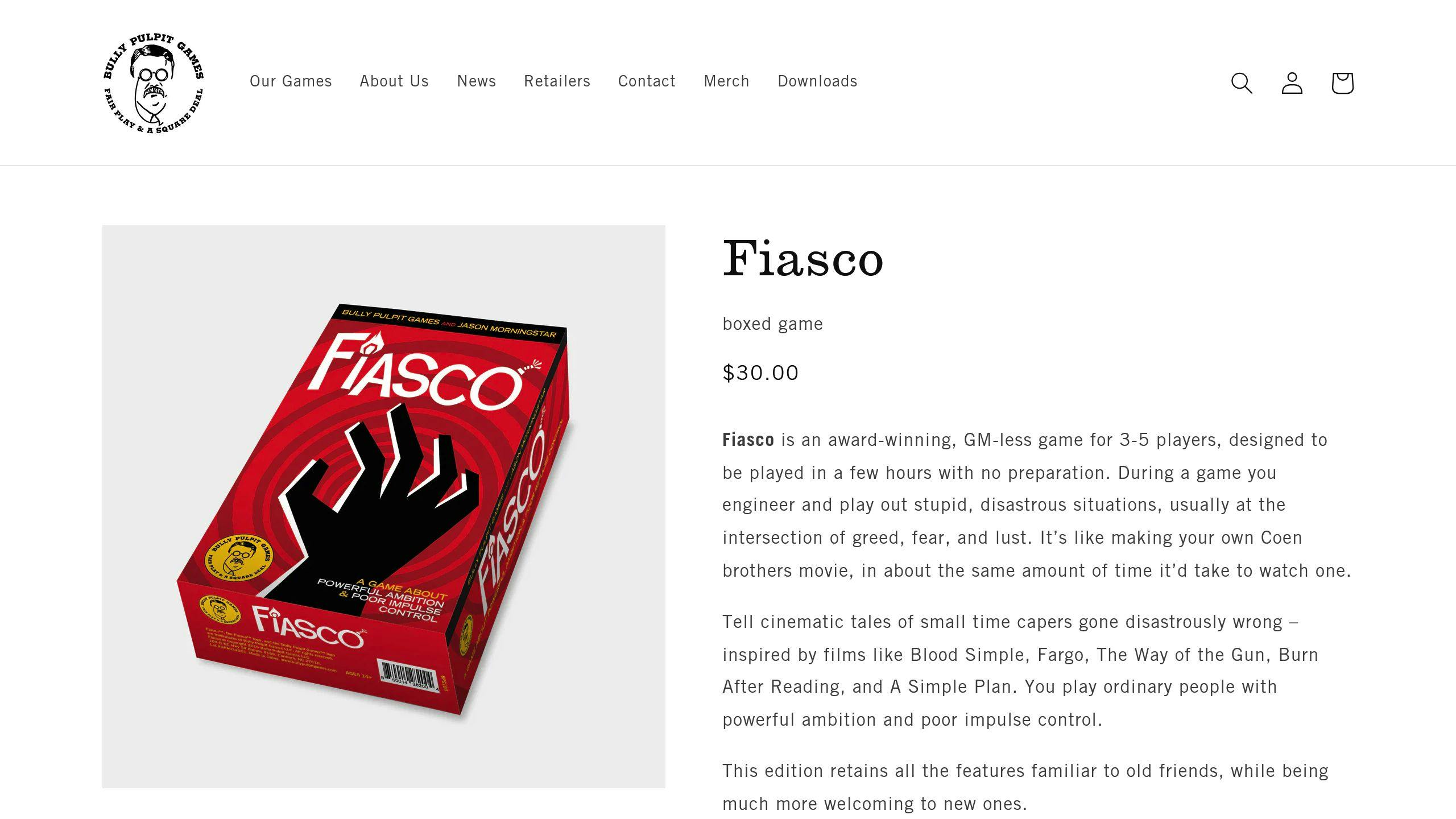
Fiasco is a standout in the world of rules-light TTRPGs, offering a memorable dive into collaborative storytelling. Designed by Jason Morningstar, this game captures the chaotic spirit of crime-gone-wrong movies. Players weave stories full of ambition, greed, and terrible decisions - all without needing a traditional Game Master.
"Fiasco is a game about making good bad choices." - Jason Morningstar, Game Designer
What makes Fiasco accessible is its simplicity. Using a sleek dice-based mechanic, the game keeps the story flowing while building tension. Instead of a rigid structure, players guide the narrative using "playsets" - themed prompts that shape the setting and character dynamics. Whether you're uncovering a small-town conspiracy or facing turmoil aboard a space station, these playsets offer just enough guidance to ignite creativity.
The game's accolades highlight its influence in indie RPGs. It won the 2009 Indie RPG Award for Best Game and the 2010 ENnie Award for Best New Game. Since then, Fiasco has become a go-to for storytelling-driven TTRPG fans.
| Game Element | Details |
|---|---|
| Player Count | 3-5 players |
| Session Length | 2-3 hours |
| Setup Time | 15-20 minutes |
| Price Range | $10 (Digital), $20-30 (Physical) |
| GM Required | No |
For first-time players, pre-made playsets are a great way to dive in. These scenarios guide you through the gameplay and teach you the core mechanics. More experienced groups often prefer creating custom playsets to tailor the game to their favorite themes and storytelling styles.
The digital version, available for $10 on DriveThruRPG, makes it even easier to jump in. An active online community adds to the fun, sharing tips, custom content, and personal experiences. Fiasco continues to thrive as a fast-paced, imaginative game anyone can enjoy.
4. The Witch Is Dead
The Witch Is Dead offers a clever spin on revenge-driven stories within the compact, rules-light TTRPG genre. In this game, players take on the roles of woodland animals on a mission to avenge their forest, targeting a witch who has wronged their community.
What sets this game apart is its simplicity. Players create animal characters with abilities that reflect their species' natural traits. Whether you're a sly fox, a clever squirrel, or a determined badger, the focus is on storytelling, not complicated mechanics. This makes it easy to pick up for newcomers while still offering seasoned players an engaging experience.
| Game Element | Details |
|---|---|
| Session Length | 1-2 hours |
| Player Count | 2-5 players |
| Character Types | Woodland animals |
| Core Mechanic | Narrative-driven |
| Setting Type | Dark fantasy forest |
Set in a dark fantasy forest, the game avoids the clichés of traditional fantasy settings. Instead, it fosters creativity and teamwork as players solve problems and weave stories about their plucky animal characters seeking justice against the witch.
"The Witch Is Dead exemplifies the growing trend toward rules-lite TTRPGs that prioritize accessibility and narrative engagement over complex mechanics."
This game is particularly fitting for those new to TTRPGs. The straightforward mechanics and the relatable concept of woodland animals with a clear goal make it simple to dive into the story. The tone is dark but playful, setting the stage for dramatic turns alongside moments of humor as tiny forest creatures outwit their powerful foe.
Best of all, the game thrives in one-shot sessions. Its tight premise and ease of play allow groups to craft a full revenge tale in just one sitting. That makes it a perfect pick for players with limited time or for groups wanting a fun, quick break from sprawling campaigns.
5. Roll for Shoes
Roll for Shoes is one of the simplest tabletop RPGs out there, born from a 2010 StoryGames forum post by DWeird. This no-frills game strips roleplaying down to its basics, putting the spotlight on storytelling and improvisation.
At its core, the game uses an incredibly straightforward system: every player starts with a single skill called "Do Anything" set at level 1. To perform an action, players roll a number of six-sided dice equal to that skill's level. Success is determined by rolling higher than the Game Master, but rolling all sixes? That’s where the fun kicks in - you develop a new, more specific skill on the spot.
| Game Element | Details |
|---|---|
| Session Length | 1-5 hours |
| Player Count | 2-6 players |
| Core Mechanic | d6 dice pool |
| Character Creation | Jump right in |
| Skill Progression | Earn it through play |
Here’s what makes Roll for Shoes a blast: the skill progression encourages out-of-the-box thinking. When players fail rolls, they earn experience points, which can be used to unlock new skills. This layer of experimentation often leads to hilarious and unexpected character developments.
"The whole point of a role-playing game isn't the game, it's the roleplaying. The game is just a container for the adventure, and the actual adventure itself happens at the table, not in the rulebooks." - Gambo, Author of Gambo's Personal Blog
Combat and character challenges rely heavily on the story rather than numbers. There’s no complicated tracking of hit points or damage; the narrative takes control, keeping everyone focused on creative solutions rather than math.
This simplicity opens the door to some unforgettable gaming moments. Picture this: a dungeon crawl that spiraled into an epic five-hour saga involving drug cartels, kidnapped royalty, and chaotic sea battles. And all of it emerged organically from player imagination and dice rolls.
With its quirky origin - rolling to see if a character is wearing shoes - and its focus on freeform storytelling, Roll for Shoes proves that a minimalist approach can result in a game packed with humor, surprises, and endless possibilities.
sbb-itb-b8b00a5
6. Goblin Quest
Goblin Quest brings a fresh mix of chaos and comedy to the world of rules-lite tabletop RPGs. This quirky game centers around hapless goblins and their laughably doomed adventures, ditching complicated systems in favor of simple, story-driven antics.
The beauty of Goblin Quest is how easy it is to dive in. No need to spend hours on character sheets - players can create their goblin characters in minutes and jump straight into the action. Perfect when you're looking for an experience that's less about rules and more about fun.
| Game Element | Details |
|---|---|
| Session Length | 2-3 hours |
| Player Count | 3-6 players |
| Core Mechanic | Story-focused outcomes |
| Character Creation | Quick and easy |
| Setting | Fantasy world |
The game's secret sauce is how it flips failure on its head. Here, failed rolls aren’t just setbacks - they lead to unexpected, hilarious twists in the story. Goblins are meant to be hilariously incompetent, and the system leans fully into that, encouraging outlandish scenarios and creative storytelling at every turn.
"The whole point of rules-lite games like Goblin Quest is to remove barriers between players and fun. When you're not worried about complex rules, you can focus on creating memorable moments and letting your imagination run wild." - RPG.net forum discussion
Game masters love this system because it’s incredibly versatile. Whether you’re planning a simple goblin errand or a wild, slapstick heist, the rules give you the freedom to shape the experience while keeping things light and entertaining. No endless rule-checking - just pure, unfiltered storytelling.
For players new to tabletop RPGs, Goblin Quest is the perfect starting point. Its simple mechanics and collaborative, humor-filled gameplay make it a welcoming choice for anyone eager to dip their toes into roleplaying. You can try silly voices, take bold risks, and fully own the chaos without getting bogged down by dense rulebooks.
7. Dread
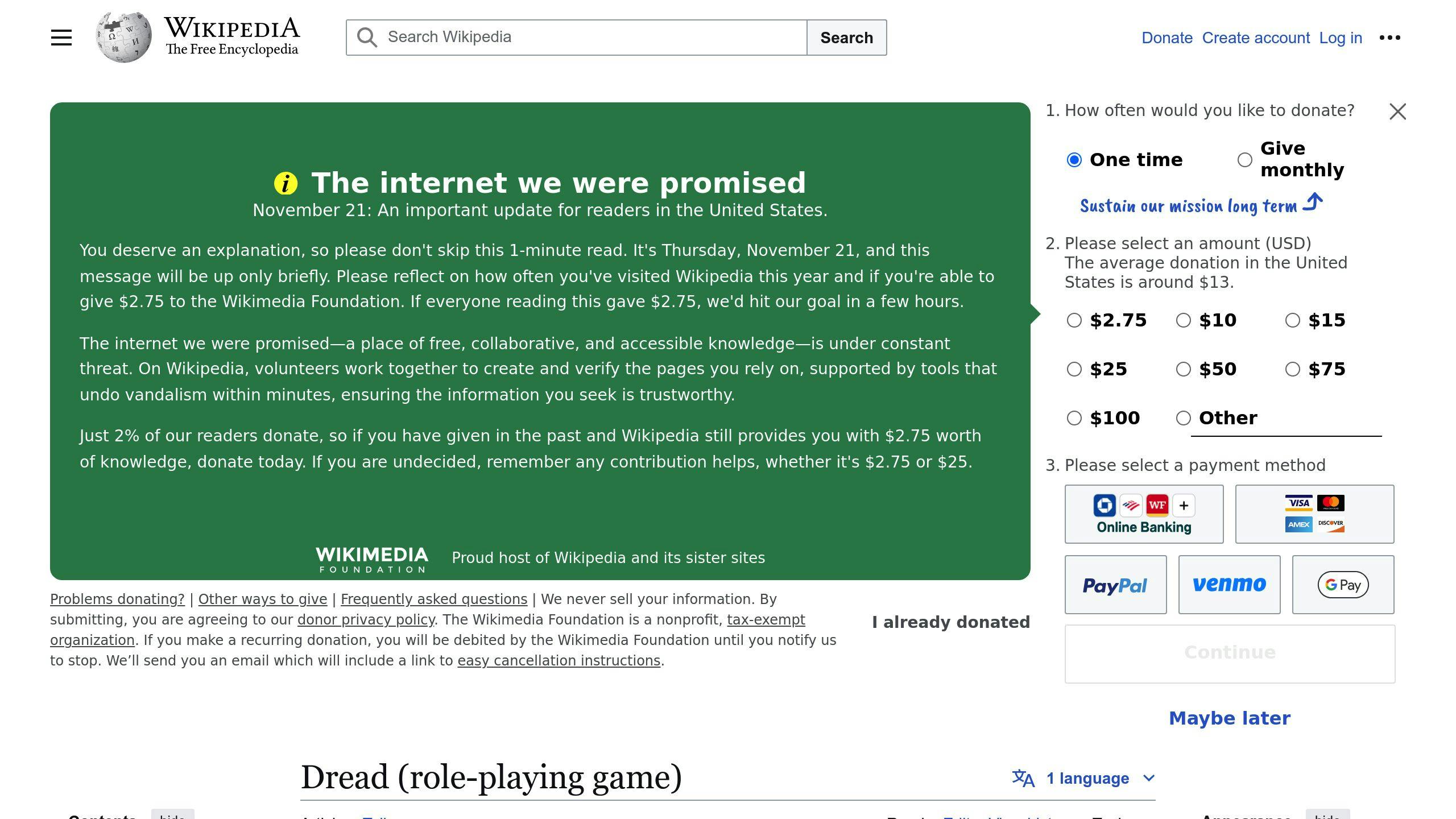
Dread takes a different approach to horror tabletop RPGs, using a Jenga tower as its core mechanic. Published by Tiltfactor, this game translates the physical tension of a wobbling tower into nail-biting narrative suspense, delivering an experience that's easy to dive into while staying intensely gripping.
| Game Element | Details |
|---|---|
| Session Length | 2-4 hours |
| Player Count | 3-6 players |
| Core Mechanic | Jenga tower pulls |
| Character Creation | Questionnaire-based |
| Price Range | $10-25 |
Instead of rolling dice, players resolve conflicts by pulling blocks from an increasingly unstable Jenga tower. This mechanic instantly raises the stakes - if the tower collapses, the consequences are severe, often leading to character death or their removal from the scene altogether. The blend of physical suspense with in-game tension creates a horror experience unlike any other.
"Dread is a game of horror and suspense. Those who play will participate in a mutual telling of an awful tale." - Tiltfactor, Dread's Official Website.
For Game Masters, Dread is perfect for one-shot horror sessions. Its simplicity lets them direct their energy toward weaving dark, chilling narratives rather than managing layers of rules. Characters are created through a questionnaire, which not only speeds up the preparation process but also builds emotional ties between players and their roles. These connections serve as perfect material for the GM to heighten the drama.
Dread’s biggest strength lies in how it links real-world stakes to in-game actions. As the Jenga tower becomes shakier, players feel genuine anxiety, mirroring their characters' fear. This seamless connection between the player’s emotions and the character’s situation makes the game deeply engaging and truly terrifying.
For those unfamiliar with horror RPGs, Dread is a fantastic starting point. Its simple mechanics keep the focus on storytelling, while the physical Jenga tower draws everyone into the atmosphere, making it easier for players to immerse themselves in the terrifying world the group creates together.
8. The Quiet Year
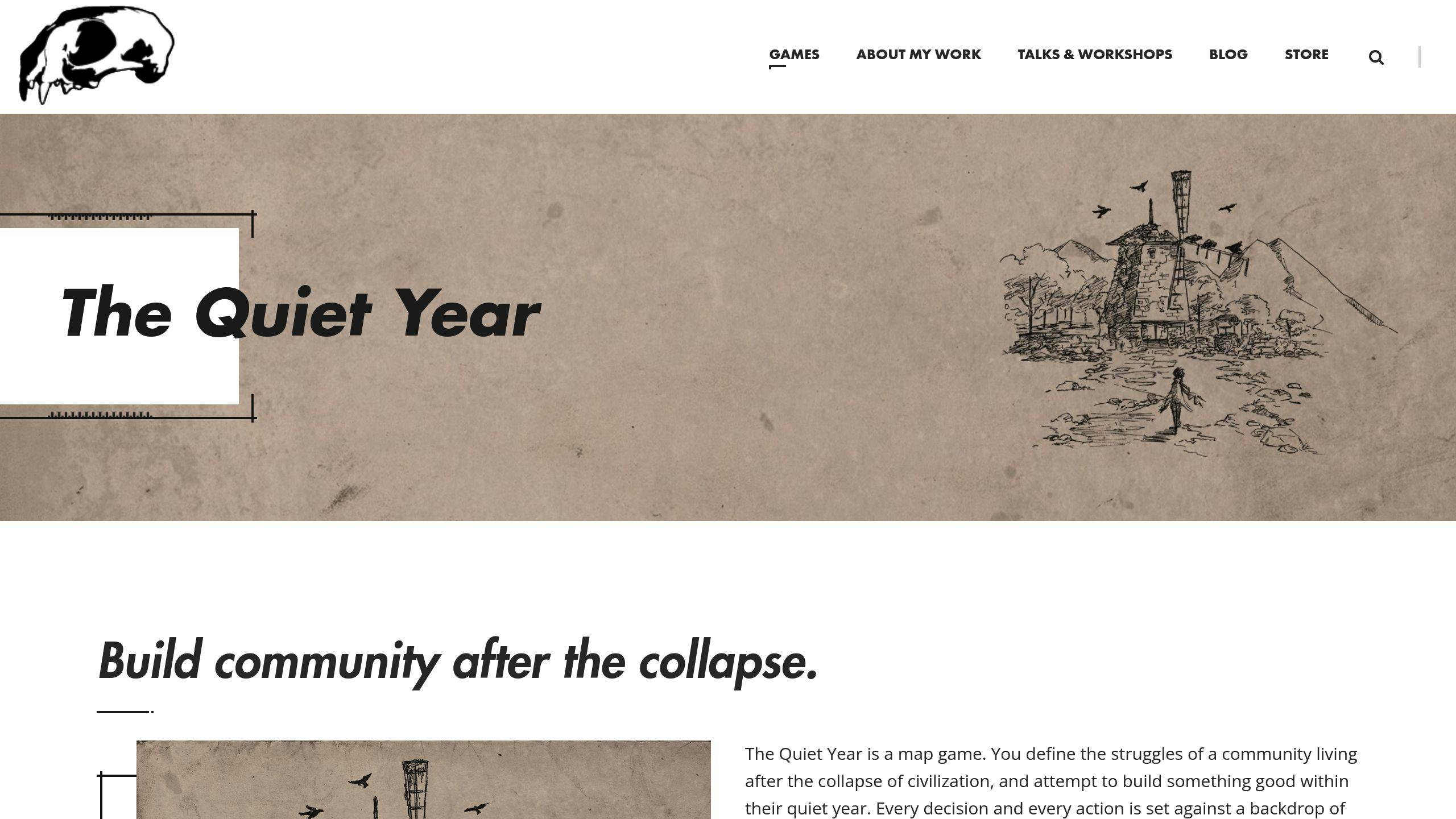
The Quiet Year, created by Avery Alder, offers a refreshing take on map-drawing games by turning community building into a collaborative storytelling adventure. Instead of traditional TTRPG mechanics, players join forces to shape their community’s fate through interactive storytelling and creative decisions.
| Game Element | Details |
|---|---|
| Session Length | 2-3 hours |
| Player Count | 2-4 players |
| Core Mechanic | Map drawing, card prompts |
| Price Range | $20-30 (physical), $10-15 (digital) |
| Age Rating | 13+ |
At its core, the game is simple yet deeply engaging. Players take turns responding to card prompts and adding to a shared map that represents their evolving community. Each choice influences the story, creating a web of events and outcomes that pull everyone into the narrative. The act of drawing directly onto the map makes the experience feel personal and immersive, strengthening players’ connections to the world they’re creating.
"The Quiet Year is designed to tell stories about communities facing change and uncertainty. It's about hope, struggle, and the decisions that shape our collective future." - Avery Alder, Game Designer
One of the standout features of The Quiet Year is how adaptable it is. Want to rebuild after an apocalypse? Prefer to shape the culture of a mystical kingdom? The game’s mechanics easily accommodate a wide range of settings, making it inviting for both fantasy lovers and fans of grounded storytelling.
The structure is smartly designed. A deck of cards paces the story across four seasons, ensuring natural arcs and keeping gameplay moving along. This avoids the drag that can sometimes happen with freeform storytelling games, offering clear direction without feeling restrictive.
For those looking for a game with light rules that sparks creativity and encourages group storytelling, The Quiet Year strikes a perfect balance. The combination of visual arts and collaborative play makes it ideal for exploring themes like survival, growth, and tough communal choices - all without the need for overly complex systems.
9. Crash Pandas
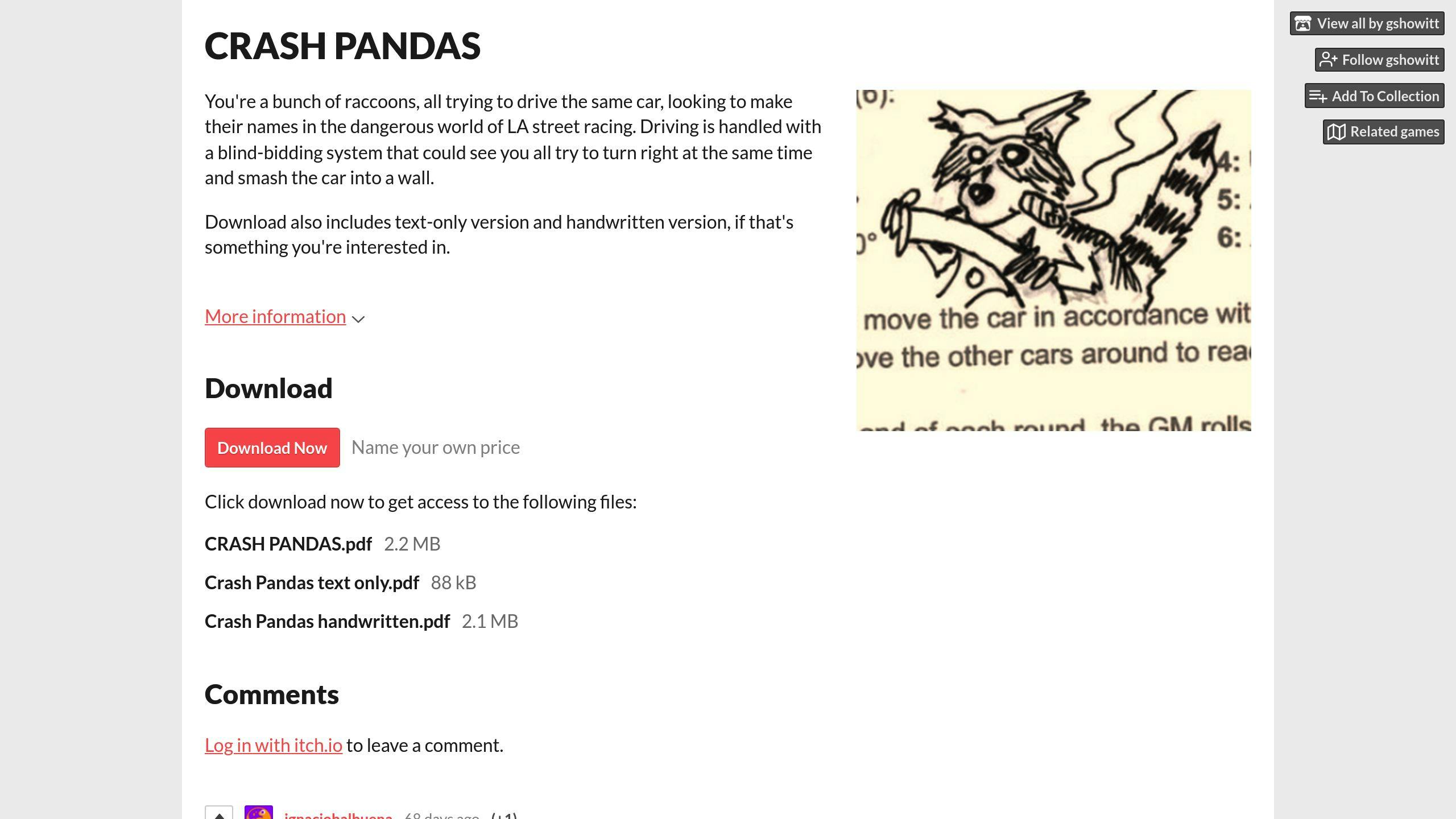
Designed by Grant Howitt, Crash Pandas brings together the thrill of street racing with a dose of chaotic raccoon antics. This simple and fast-paced tabletop RPG (TTRPG) puts players behind the wheel - well, sort of. You're raccoons after all, with a knack for stealing cars and causing mayhem on the streets.
| Game Element | Details |
|---|---|
| Session Length | 1-2 hours |
| Player Count | 3-5 players |
| Core Mechanic | Simple dice rolling |
| Price Range | $10-15 (digital) |
| Age Rating | 12+ |
The charm of this game lies in how streamlined it is. With straightforward rules, everything revolves around the story and the chaos your raccoon characters create. You'll piece together your raccoon's "skills", hop into stolen cars, zip through city streets at wild speeds, and - of course - try to stay a step ahead of the cops.
"Crash Pandas is a game about raccoons stealing cars and racing them. It's a game about being cool, and about being a raccoon." - Grant Howitt, Creator of Crash Pandas
What makes Crash Pandas so special is its mix of ridiculous humor and engaging gameplay. There's no need to sift through dense rulebooks. Instead, you'll spend your time describing cinematic stunts, outrageous heists, and impossible raccoon teamwork. The straightforward mechanics and funny premise make it a welcoming choice for those new to TTRPGs. Everyone gets the concept: street racing, but with raccoons. Easy to jump in, impossible not to laugh.
The game is available digitally on platforms like itch.io and DriveThruRPG, offering easy access to everything you need. Adding to the fun, players regularly share stories, custom rules, and creative race ideas on social media, keeping the game's community thriving and the replayability endless.
If you're already a fan of Howitt's incredibly popular game Honey Heist, you'll feel right at home. Like Honey Heist, Crash Pandas focuses on quick, hilarious storytelling without bogging you down in complex rules. It's perfect for anyone who loves games where the chaos and laughter take center stage.
10. Cthulhu Dark
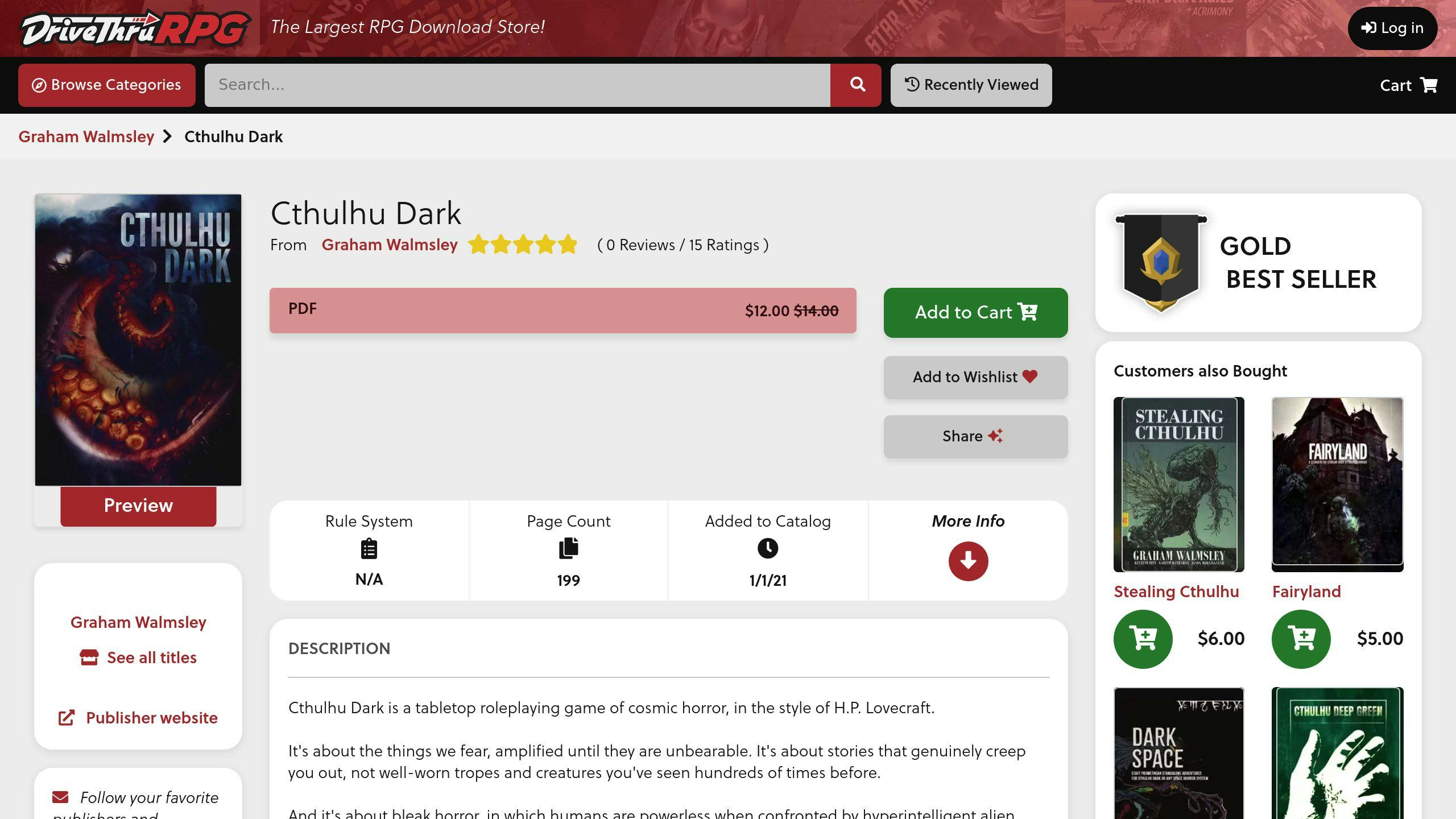
Created by Graham Walmsley, Cthulhu Dark is a minimalist tabletop role-playing game (TTRPG) that perfectly distills the eerie essence of Lovecraftian horror. With its simple mechanics and emphasis on storytelling, it’s an ideal pick for those who love psychological horror and mystery.
| Game Element | Details |
|---|---|
| Core Mechanic | Single d6 roll + skill level |
| Focus | Investigation & psychological horror |
| Price Range | $10-20 |
| Best For | Horror enthusiasts & story-driven players |
| Session Length | 2-3 hours |
The brilliance of Cthulhu Dark lies in its straightforward gameplay. Players roll just one six-sided die, add a skill level when applicable, and aim for a 4 or above to succeed. This simplicity removes much of the complexity found in other cosmic horror games, turning the spotlight on the narrative rather than the mechanics.
"Cthulhu Dark is about creating a sense of dread and uncertainty, using simple mechanics to tell complex stories." - Graham Walmsley, Designer of Cthulhu Dark
Unlike many horror TTRPGs that lean into combat-heavy systems, Cthulhu Dark focuses entirely on investigation and the chilling psychological toll of encountering the unknown. Each roll isn’t just a mechanical action - it becomes a moment of tension where outcomes impact the story and your character’s grip on reality.
The game is available digitally on platforms like DriveThruRPG or in physical copies from hobby shops. Expansions and supplements offer fresh settings and scenarios to explore, and the active fan community frequently shares adventures and ideas online. These resources make it easy for new Game Masters to dive in without the stressful prep work.
If you've played more intricate Lovecraft-inspired games like Call of Cthulhu, you'll find Cthulhu Dark to be a refreshing change. It delivers the same eerie, cosmic horror experience but strips down the rules, making it accessible to both seasoned players and those just dipping their toes into investigative horror. Whether you’re after tension-filled storytelling or simply want a rules-light experience, Cthulhu Dark doesn’t disappoint.
Game Features at a Glance
To help you easily compare these rules-light TTRPGs and pick the right fit for your group, here’s a quick look at their standout features:
| Game Title | Game Type | Rules Difficulty | Playing Time | Player Count | Key Feature |
|---|---|---|---|---|---|
| Honey Heist | Comedy/Heist | Very Simple | 2-3 hours | 3-6 players | Single-page ruleset |
| Lasers & Feelings | Sci-Fi Adventure | Very Simple | 1-2 hours | 2-6 players | One-roll resolution |
| Fiasco | Crime Drama | Simple | 2-3 hours | 3-5 players | GM-less play |
| The Witch Is Dead | Dark Fantasy | Very Simple | 1-2 hours | 2-4 players | Revenge narrative |
| Roll for Shoes | Universal | Very Simple | 1-3 hours | 2-6 players | Dynamic skill creation |
| Goblin Quest | Fantasy Comedy | Simple | 1-2 hours | 2-5 players | Multiple character lives |
| Dread | Horror | Simple | 2-4 hours | 3-6 players | Jenga-based resolution |
| The Quiet Year | Post-apocalyptic | Moderate | 3-4 hours | 2-4 players | Map-drawing focus |
| Crash Pandas | Racing Comedy | Very Simple | 1-2 hours | 3-5 players | Dice-pool racing |
| Cthulhu Dark | Cosmic Horror | Simple | 2-3 hours | 2-5 players | Single d6 system |
These games take different approaches to simplified tabletop experiences, each with its own twist. A long-time TTRPG fan on the RPGnet Forums put it best: "Rules-lite systems are especially effective for teaching people who have little to no experience with TTRPGs in general."
The beauty of these games lies in how quick they are to pick up. Most can be taught in less than 15 minutes, requiring little prep for the Game Master (if there's one at all). “Very Simple” games are ready to go almost immediately with a quick rundown of the rules, while “Simple” ones might need a brief read-through and a practice round to lock in the mechanics.
The session lengths listed are typical but flexible - feel free to adjust based on how much time your group has. The player counts represent the ideal range for a smooth and engaging experience, though many of these games can stretch to fit more or fewer participants as needed.
Final Thoughts
Rules-lite TTRPGs have reshaped tabletop gaming by making roleplaying simpler and more fun for everyone, regardless of experience. These streamlined systems let you dive right into the story, keeping the focus on creativity and interaction rather than flipping through rulebooks.
When selecting your first rules-lite game, think about your group's preferences and experience. For brand-new players, single-page games like Lasers & Feelings or Honey Heist are excellent introductions. They’re so straightforward that you can usually explain the rules in under 15 minutes, letting everyone jump straight into crafting characters and stories without worrying about complicated mechanics.
"Rules-lite games are ideal for players who want to focus on storytelling and role-playing rather than complex rules. The emphasis on narrative over mechanics creates a more immersive experience", says a trusted TTRPG community moderator.
If your group is moving from more traditional TTRPGs, consider a title like Goblin Quest, which strikes a nice balance. Its quirky design gives each player multiple characters (five goblins!), making it easy to experiment and learn while still delivering engaging gameplay. This format is especially great for seasoned players looking to loosen up and explore less rigid gaming styles.
While many rules-lite games are perfect for one-shots and short sessions, some are well-suited for longer campaigns. The Quiet Year and Cthulhu Dark, for example, offer enough depth to sustain extended play without losing their straightforward approach. The trick is finding what works best to keep your group entertained over time.
Keep in mind that the Game Master's role is crucial in these systems. Rules-lite games often depend on the GM’s creativity and ability to guide the story, which can be wonderful for experienced GMs but might feel overwhelming for beginners. If you’re new to GMing, consider options like Fiasco, which shares storytelling duties among all players, making it easier to manage.
The charm of rules-lite TTRPGs is in their focus on collaboration and storytelling. Whether you're hosting a casual game night or introducing friends to roleplaying for the first time, these systems provide a laid-back yet engaging way to create unforgettable adventures without being bogged down by complex rules.
FAQs
What is the easiest tabletop RPG to play?
If you're looking for easy-to-learn tabletop RPGs, there are a few titles that are perfect for jumping right in. Goblin Quest is a standout. It's well-known for its simple rules and quick setup, making it ideal for beginners. In this game, players create goblin characters and dive into the fun almost immediately.
For first-timers who want an even simpler start, single-page RPGs like "Into the Odd" are a great option. These games cut out heavy mechanics while still delivering engaging experiences.
"The lie of the ultra-lite is that you can capture the quintessential nature of D&D despite largely removing its progression and Gygaxian building blocks." - Prince of Nothing Blogs
If you're interested in storytelling-focused games, the Fate Core System is worth considering. It shifts the emphasis from intricate rules to imaginative storytelling, which is great for those who want to explore narratives without feeling bogged down by complicated rulebooks.
For more seasoned groups looking to try something new, Fiasco might be the answer. Its approach to collaborative storytelling, without the need for a Game Master, makes it an excellent choice for group creativity and shared involvement.
Here are some elements that make these games beginner-friendly:
| Feature | Why It Helps |
|---|---|
| Few Rules | Easy to learn in minutes |
| Open-Ended Storytelling | Encourages creative ideas |
| Fast Character Creation | Gets everyone playing quickly |
| Collaborative Play | Spreads the focus evenly |
Choosing the "easiest" RPG depends largely on what your group enjoys. Whether you prefer imaginative stories, casual gameplay, or something in between, aim for a system that fits your vibe rather than just one with minimal rules.

